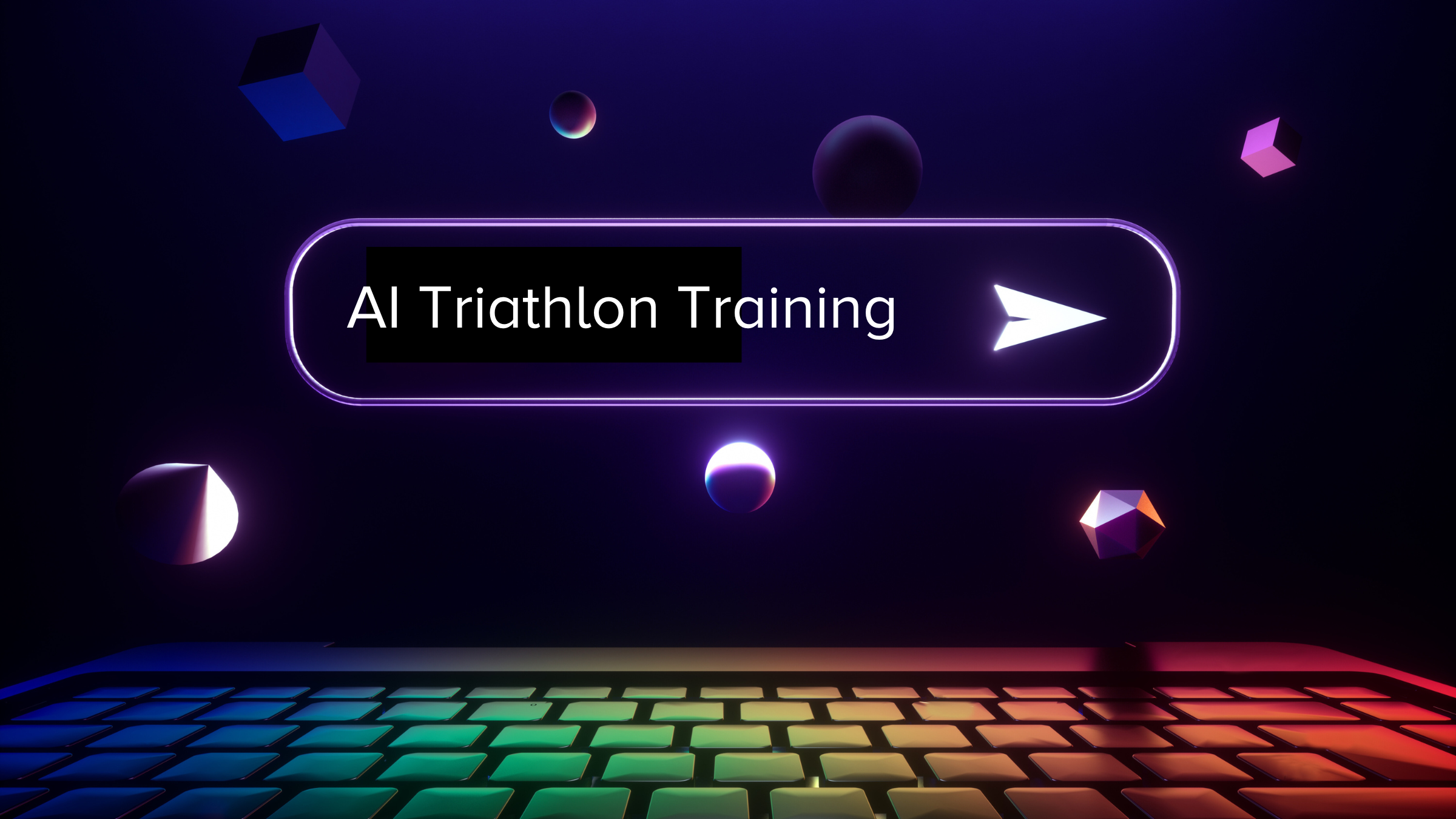Strength, Coaching, and Nutrition: Triathlon’s Version of the Tech Arms Race

AI triathlon training data and insights keep getting better. Here's what you should know about these tools. (Photo: Getty Images)
Triathletes are quintessential early adopters. Aerobars? Yeah, we started that. Even super shoes were spotted proportionally en masse at Ironman World Championships well before the general running and marathoning crowd wanted to put more (carbon) pep in their step.
Whether it’s buying your first smartwatch, measuring your HRV, or hiring a coach to analyze your data, jumping on the science and technology bandwagon is practically a rite of passage on the progress from beginner to advanced triathlete.
And just as WorldTour cycling teams are beginning to use artificial intelligence to help make sense of mountains of data, triathlon is not too far off.
Below, we’ll take a look at three exciting frontiers of innovation in endurance sports – as Hexis AI nutrition app founder David Dunne put it: “The research starts in the elites and is applied in the elites … then trickles down to the everyday athlete.”
Spotter, trainer, spy: AI in the gym
While watching the lead-up to the Sydney Olympics back in 2000, Asensei founder Steven Webster remembers an attempt made to digitally motion capture U.S. hurdler Lolo Jones. The aim? To figure out, to the hundredths of a second, how she could successfully qualify.
“Elite athletes had access to ‘the BMWs’ of cameras and performance teams,” he says. “That was a real inspiration for me: How are we going to take the work of wizards and give it to mere mortals?”
Twenty-five years later, Asensei’s intelligent movement recognition has been built into over 20 consumer apps, such as Alter, the at-home fitness system, Chris Hemsworth’s CENTR, and LITESPORT, where real trainers meet you face-to-face in virtual reality and bring you motivation and tips to fuel your progress.
“It’s basically, ‘How do I identify the thing that you’re doing at whatever level of skill you’re able to do it and then make a decision about how well you’re doing it,'” Webster explains.
The next frontier for triathletes when it comes to strength, mobility, and injury prevention and maintenance, is about personalization.
“Say we’re doing our strength training or our mobility work in front of our fitness mirror, but you’re getting coached on your tight hamstrings and I’m getting coached on my right hip flexor,” Webster explains.
Or take run form analysis: He says the difference is, we’re not filming you on a treadmill and then coaching you based on the data. “Rather, you’d be running on a treadmill and getting cues in your ear telling you to lengthen your stride or pick up your knees.”
That’s the AI difference.
By using large language models that have been trained on a certain coach’s articles and training philosophy, athletes can receive direction in that coach’s own unique style. “That’s where it’s going next … speaking to the coach that’s on your mirror or in your room.”
Further down the road of innovation, Asensei is working with a partner to develop body composition analysis like DEXA scans, from a couple of images, as another example of democratization of a currently expensive laboratory-only service.
Meet your new, always-on AI triathlon training coach
“Hello, Jennifer. Today is Monday. After evaluating your program for today and tomorrow, let’s discuss your current fitness and training status in the context of your training plan. For today, you have a bike session of approximately 50 minutes (…) don’t lose momentum!”
This is the message from my Athletica.ai coach avatar when I logged in today. None of my past coaches, no matter how good, ever commented on my workouts with such immediacy and detail. (For an athlete who’s been known to obsessively refresh TrainingPeaks comments, the equal doses of gold stars and tough love is addictive.)
By now most of us have dabbled with “smart” coaching apps in which workouts are prescribed by algorithms, not human coaches. In go your metrics, goals, and available training time; out comes a free, or very affordable, training plan. (See our review of 4 AI training apps.)
With founder Paul Laursen at the helm, cutting-edge, scientific innovation is Athletica’s DNA. Laursen is a performance physiology coach and adjunct professor at the High Performance Sports Center in New Zealand, a researcher at the University of Agdar in Norway, and co-author of The Science and Application of High-Intensity Interval Training. He was PhD advisor to Dan Plews, who has coached numerous high-level pros, including Chelsea Sodaro. Laursen himself has worked with Ironman champions Andi Boecherer and Kyle Buckingham.
Athletica is a science-based AI tool built on decades of applied sports science (from over 150 peer-reviewed studies, Laursen’s book, and real-world coaching) to provide training and analysis for users and coaches alike. All this is done while blending AI with a coach’s reasoning process. It’s like having a lab at your fingertips, all with data pulled from your wearable.

Its personalized training prescription is based on objective inputs like power, pace, HRV, and sleep data, and subjective feedback like RPE and mood tracking. At onboarding, it pulls in two years of an athlete’s training history. Lastly, it looks to science – like principles from Laursen’s book, intensity-duration curves, etc., to “predict adaptation and prescribe the right stimulus at the right time,” as Laursen puts it.
Athletica’s AI then cross-references these elements to optimize each athlete’s plan dynamically.
“Tomorrow’s session is adjusted to be optimal no matter what,” Laursen says. He adds that this is “true AI,” – not the algorithmic logic used by most apps, in that “it uses machine learning … to analyze patterns, adjust based on real-time physiological feedback, and learns from individual trends over time.”
Adds Laursen: “There’s that adage about the rising of the tide lifting all boats. The tide is rising on AI – the genie is out of the bag.”
And in a big way. Athletica recently partnered with VF Group Bardiani-CSF Faizanè, the UCI ProTeam, and with Cal Tri events, one of the largest short-course triathlon series in the U.S.
An AI nutritionist in your pocket
As Laursen says, AI will “democratize high-performance insights, making world-class training available to everyone.” When it comes to trickle-down technology, nutrition science is also making a move.
Hexis.live is one example. In 2018, Hexis co-founder Dr. Sam Impey published a paper that disrupted sports nutrition. In it, he introduced the concept of “carb coding;” essentially, this ability to enhance performance, recovery, and adaptation to exercise through the proper amount and timing of carbs. If you’re a nutrition nerd, you’ve likely come across this concept in apps like FuelIn, or Impey’s own Hexis, founded with fellow PhD, David Dunne.
Hexis intends to bring the type of nutrition insight that used to only be available to elite athletes to amateurs. You simply sync up your training plan and Hexis will automatically adjust your meal plan to make sure you’re fueling optimally for your training and recovery.
Dunne, who has coached Olympians and world champions in a variety of sports, built Hexis to solve a problem of scalability: “I was frustrated that I couldn’t deliver the level of personalization that you’d want to deliver to an athlete on a daily basis,” he says. “Humans just can’t scale, you know, 24 hours a day, 365 days of the year.”
This is where technology comes in again, to augment, not replace, humans. Hexis delivers daily, personalized meal plans periodized according to the type, the intensity, and the duration of an athlete’s activity.
“If you planned on doing a four-hour ride at 200 watts and you end up doing four-and-a-half at 220, we’ll immediately update what that recovery period looks like and start to iterate on that throughout the course of the day,” Dunne explains. “We’re like having a nutrition coach in your pocket 24/7.”
Hexis has recently signed 10 professional cycling teams, including Education First and UnoX Mobility (coached by Olav Aleksander Bu, of Norwegian triathlete fame).
Dunne says Hexis was built on the principles of physiology, exercise, metabolism, and nutrition, and then jazzed up with additional AI tools to improve the experience overall.
For example, instead of manually typing in “one banana, 2 cups oatmeal,” you can send a voice note that says, “for breakfast, I had one banana, and a medium bowl of porridge.” Hexis converts the voice to text, looks up the foods in its database, picks out the portion sizes, and then calibrates your data.
Or, you can simply take a picture of your food with your phone.
Dunne says their research is a classic example of the trickle-down technologies: “People now know that they should be adjusting their fueling according to their training. Some days they need 60 grams of carbs per hour, some days they might need to push it to 100.”
“If you get your needs right, it can really make a difference.”
Next-Gen AI As “Data Flood Control”
If you’ve got a wearable on your wrist, you’ve got information. If you’re using a power meter, a heart rate monitor, or a Whoop, you’re generating even more data.
And whether it’s you, your coach, a computer–or some combination of the three—making sense of this ever-increasing stockpile of information, the “wisdom of wizards” is there for the taking.
For those of us who’re ready, all we have to do is ask.
As for me, I’ll just be over here, clicking on my Athletica coach avatar for the 20th time today.